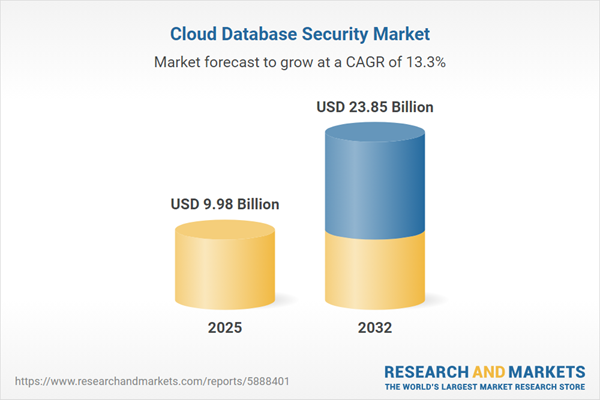Speak directly to the analyst to clarify any post sales queries you may have.
Cloud database security is becoming indispensable for enterprises modernizing their data infrastructure. This report delivers actionable intelligence on how organizations can address new security challenges as digital transformation accelerates and cloud adoption becomes central to business strategy.
Cloud Database Security Market Snapshot
The Cloud Database Security Market grew from USD 8.78 billion in 2024 to USD 9.98 billion in 2025. It is forecasted to maintain a compound annual growth rate (CAGR) of 13.29%, reaching USD 23.85 billion by 2032. Sustained investment in cloud-native architectures, advanced threat defenses, and compliance-driven deployments are core contributors to global market momentum. This accelerating growth reinforces that database security is now a strategic priority for businesses of all sizes and across industries.
Scope & Segmentation
This report gives in-depth coverage of technologies, organizational contexts, service offerings, industry adoption, and geography:
- Database Types: Non-relational (document, graph, key-value, wide-column) and relational (MySQL, Oracle, PostgreSQL, SQL Server) architectures, each with distinct security needs.
- Organization Size: Large enterprises as well as small and medium-sized enterprises, each with unique requirements and security deployment patterns.
- Deployment Models: Hybrid cloud, private cloud, and public cloud environments, with attention to policy orchestration and shared responsibility models.
- Security Services: Access control, backup and recovery, compliance and auditing, data encryption, database firewall, threat detection—all contributing to layered database protection.
- End-User Verticals: Banking, financial services and insurance (BFSI), government and defense, healthcare, IT and telecom, and retail and e-commerce, reflecting sectoral priorities across data protection, compliance, and resilience.
- Geographic Regions: Americas (United States, Canada, Mexico, Brazil, Argentina, Chile, Colombia, Peru), Europe, Middle East and Africa (United Kingdom, Germany, France, Russia, Italy, Spain, Netherlands, Sweden, Poland, Switzerland, United Arab Emirates, Saudi Arabia, Qatar, Turkey, Israel, South Africa, Nigeria, Egypt, Kenya), and Asia-Pacific (China, India, Japan, Australia, South Korea, Indonesia, Thailand, Malaysia, Singapore, Taiwan).
- Industry Leaders Analyzed: Amazon Web Services, Microsoft Corporation, Google, Oracle Corporation, IBM, Palo Alto Networks, Fortinet, Check Point Software Technologies, CrowdStrike, and Zscaler.
Key Takeaways for Decision-Makers
- Cloud database security is evolving from reactive controls to integrated, proactive risk management as organizations shift towards distributed and multi-cloud environments.
- Adoption of zero trust frameworks, microsegmentation, and real-time analytics is rapidly redefining traditional security models and roles, placing emphasis on transaction verification and minimizing lateral movement risks.
- Technological innovations—such as containerized workloads and serverless computing—are expanding the attack surface and demanding dynamic, granular policy enforcement.
- Security investment strategies are increasingly shaped by regulatory imperatives around data residency, privacy, and industry-specific mandates. Seamless integration of compliance controls is now essential across regions and sectors.
- Vendor consolidation, open source adoption, and robust orchestration frameworks are being prioritized for long-term optimization of cloud database security operations.
- Strategic alliances between hyperscalers, specialized security firms, and open source communities are accelerating interoperability and helping enterprises manage multi-vendor, cloud-native environments.
Tariff Impact: U.S. 2025 Tariffs on Cloud Database Security
- The introduction of 2025 U.S. tariffs on certain hardware components is driving up costs for encryption modules and high-performance appliances, impacting sourcing decisions across the sector.
- Major vendors are responding with revised pricing models, increased service bundling, and longer-term contracts to ease the financial impact on end users.
- Enterprise buyers are turning to open source and subscription-based offerings, balancing cost with flexibility, while vendors diversify manufacturing locations to blunt tariff-related volatility.
Methodology & Data Sources
The analysis draws from in-depth interviews with security executives, direct surveys on technology adoption, and comprehensive secondary research, including regulatory reviews and vendor roadmaps. Structured frameworks and expert peer review ensured analytical rigor and reliable conclusions for this cloud database security market research.
Why This Report Matters
- Enables senior leaders to benchmark database security strategies and align technology investment with evolving risks and compliance trends.
- Supports strategic planning by mapping organizational, technological, and geographic factors that shape security architectures and supplier evaluation.
- Delivers actionable insights on competitive landscape shifts and the impact of policy and economic changes, such as tariffs, on procurement strategies.
Conclusion
Senior decision-makers can leverage this report to anticipate evolving security challenges, adopt resilient strategies, and ensure robust protection of organizational data assets as the cloud landscape matures.
Additional Product Information:
- Purchase of this report includes 1 year online access with quarterly updates.
- This report can be updated on request. Please contact our Customer Experience team using the Ask a Question widget on our website.
Table of Contents
3. Executive Summary
4. Market Overview
7. Cumulative Impact of Artificial Intelligence 2025
Companies Mentioned
The companies profiled in this Cloud Database Security market report include:- Amazon Web Services, Inc.
- Microsoft Corporation
- Google LLC
- Oracle Corporation
- International Business Machines Corporation
- Palo Alto Networks, Inc.
- Fortinet, Inc.
- Check Point Software Technologies Ltd.
- CrowdStrike Holdings, Inc.
- Zscaler, Inc.
Table Information
| Report Attribute | Details |
|---|---|
| No. of Pages | 194 |
| Published | November 2025 |
| Forecast Period | 2025 - 2032 |
| Estimated Market Value ( USD | $ 9.98 Billion |
| Forecasted Market Value ( USD | $ 23.85 Billion |
| Compound Annual Growth Rate | 13.2% |
| Regions Covered | Global |
| No. of Companies Mentioned | 11 |









